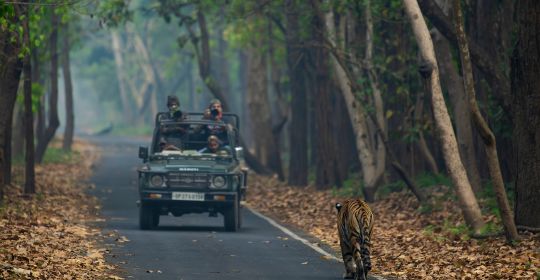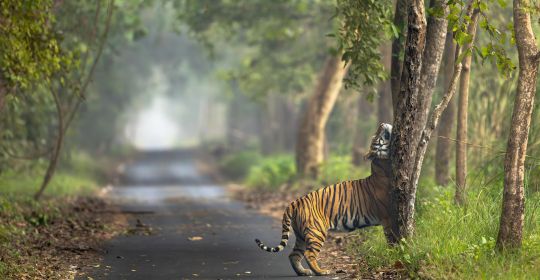Nestled in the Terai region, Pilibhit National Park is an eco-paradise known for its dense forests, serene rivers, and variety of flora and fauna, making it a perfect destination for nature lovers and wildlife enthusiasts.
Pilibhit Tiger Reserve in Uttar Pradesh is a thriving habitat spread across the Terai belt, celebrated for its rich biodiversity, picturesque landscapes, and dedicated efforts to protect the Royal Bengal Tiger.
Pilibhit National Park also known as Pilibhit Tiger Reserve, located in Terai region of Uttar Pradesh, is a lush sanctuary renowned for its sal forests, diverse wildlife, and significant role in tiger conservation.
Pilibhit Tiger Reserve, covering vast stretches of forest and grassland, is one of India’s finest tiger habitats, attracting visitors with its thrilling wildlife safaris, scenic beauty, and commitment to conservation efforts.

Earth Home Pilibhit offers a perfect blend of wildlife adventure and serene comfort.
Nestled close to the forest in Pilibhit, Bagh Home Stay is a serene retreat that blends rustic charm with warm hospitality.

Pilibhit National Park offers both Morning and Afternoon Safari opportunities, allowing you to witness the captivating wildlife in their natural habitat.

The morning safari usually starts around sunrise, offering the best chances to spot wildlife during their active hours. Timings may vary slightly based on seasonal changes.
Winter : (1st November to 31st March) 6.30 am to 10.00 am
Summer : (1st April to 15th June) 6.00 am to 9.30 am
experience, making it a paradise for nature lovers and wildlife photographers.

The afternoon safari typically begins in the early afternoon and extends until sunset. This session also provides an excellent opportunity to observe the behavior of animals as they prepare for the night.
Winter : (1st November to 31st March) 2.30 pm to Sunset
Summer : (1st April to 15th June) 3.30 pm to Sunset

6.30 am to 10.00 am 2.30 pm to Sunset
6.00 am to 9.30 am 3.30 pm to Sunset

A Sanctuary of Wilderness and Conservation Excellence
Pilibhit Tiger Reserve, located in the lush Terai region of Uttar Pradesh, is a mesmerizing expanse of pristine forests, rolling grasslands, and rich wetlands. Officially declared a Tiger Reserve in 2014, it is one of India’s most significant conservation success stories, dedicated to the protection of the Bengal Tiger and the diverse ecosystem of the Indo-Gangetic plains.
Covering 730.2 km², the reserve forms a part of the Terai Arc Landscape (TAL), an extensive ecological corridor linking India and Nepal. It is uniquely enclosed by natural boundaries, including the Sharda River to the east, Khakra River to the west, and the Indo-Nepal border to the north, creating an ideal sanctuary for wildlife.
Pilibhit Tiger Reserve plays a pivotal role in India’s wildlife conservation efforts, serving as a key link in the Dudhwa-Pilibhit-Katarniaghat forest complex, ensuring the genetic diversity and sustainability of its thriving tiger population.

From Hunting Grounds to a Tiger Haven
The history of Pilibhit Tiger Reserve dates back to the British colonial era, when it was a renowned hunting ground for royalty and British officials. These dense forests, once abundant with tigers, leopards, and other wildlife, were exploited for sport. However, with the rising global awareness of conservation, these forests gradually received protected status.
In 2008, the Government of India and the National Tiger Conservation Authority (NTCA) identified Pilibhit’s rich biodiversity and high tiger density as crucial for conservation. Consequently, in 2014, it was officially declared India’s 45th Tiger Reserve, marking a major milestone in the country’s conservation journey.
Over the years, Pilibhit has transitioned from a hunting hotspot to a thriving tiger stronghold, earning international recognition for its commitment to wildlife preservation.

A Dynamic Blend of Habitats
Pilibhit National Park boasts a stunningly diverse terrain, supporting a variety of ecosystems:
The seasonal flooding from Himalayan rivers rejuvenates the land, ensuring fertile soil and lush vegetation, which in turn supports a rich and dynamic ecosystem.
A Key Component of the Terai Arc Landscape
Pilibhit is part of the Terai Arc Landscape (TAL), a cross-border conservation initiative that safeguards critical habitats across Uttar Pradesh, Uttarakhand, and Nepal. This landscape remains one of the last surviving strongholds of the Terai grassland ecosystem, home to numerous endangered species.
Major Contributions of Pilibhit Tiger Reserve:
These factors make Pilibhit a crucial conservation site with both national and global significance.
An Overview of Pilibhit’s Tigers
Pilibhit is home to a thriving population of Bengal Tigers (Panthera tigris tigris), which have adapted to the unique habitat of the Terai region. The reserve’s dense forests and abundant prey base provide an ideal environment for tigers to flourish. The tiger population in Pilibhit has witnessed a remarkable recovery, with their numbers increasing significantly in recent years, earning the reserve global recognition.
Notable Tigers and Their Lineage
Many individual tigers have gained recognition among conservationists and wildlife enthusiasts due to their unique markings, behavior, and success in raising cubs. Some well-known tigers in Pilibhit include:
The growing population of cubs, many fathered by dominant males like Rudra and Veer, ensures that Pilibhit continues to be a stronghold for Bengal Tigers.
Unique Features of Pilibhit’s Tigers
Pilibhit’s tigers display some fascinating behaviors and adaptations:
A Hidden Jewel Among India’s Tiger Reserves
Unlike heavily commercialized reserves such as Jim Corbett and Ranthambore, Pilibhit offers an undisturbed, intimate wildlife experience, making it a paradise for nature lovers and wildlife photographers.

Nearest Airport is Lucknow which has direct flights to all major cities of India.
1- From Lucknow via Sitapur, Shahjahanpur, Bareilly, Pilibhit
2- From New Delhi via Moradabad, Bareilly, Pilibhit
3 – Pilibhit is also very well connected to Bareilly by BUS at the frequency of ½ hr. Direct buses are also available from Delhi, Lucknow, Haridwar, Rishikesh, Kanpur, Rupaidhiya, Agra and Tanakpur etc.

It is situated between Sharda dam and canal. It is a beautiful tourist destination with one bamboo hut, one tree house and four Thara huts. Best time to visit Chuka beach is between the month of October and April.
One such safari is Jungle safari. It can also be defined as a forest trail, except that instead of walking, hiking or trekking, you have also got the options of exploring the forest regions via a jeep or a elephant ....
In the Red Data Book of CN, this giant snake python, which has been successfully shown in every habitat of Pilibhit Tiger Reserve, comes out along the path of the endangered wildlife.
IU has been listed in the category, ...
The favorite marshy grass of reindeer grows in this pond. Due to which the herd of reindeer is often seen here.
The barasingha is a large deer with a shoulder height of 44 to 46 in (110 to 120 cm) ...
Smooth-Coated Otter
Lutrogale persplcillata
The otters that depend on water habitats can be seen in the Pilibhit Tiger Reserve with its water sports attracting tourists. It mainly depends ...
Crocodile is a skilled and powerful swimmer, which is found abundantly in every submerged parts of Pilibhit Tiger Reserve. It is usually easily visible from small water lakes to river estuaries. Its main habits include sunbathing
Birds like Grenville, Lalkar, Neelkar, Agred, Kautilya grade come to enjoy the winter every year by covering a distance of over km at various water sources including Sharda Sagar Dam.


No matter the reason, your message is important to us. We’re always happy to assist with inquiries about our services, provide more information, or simply connect with people who are interested in what we do.
You can contact us via email, phone, or by filling out our enquiry form. If you’re nearby, feel free to stop in—we always enjoy a good face-to-face chat.
Let’s connect and make something great happen!
Just fill in the form and we will get back to you.

Pilibhit National Park, located in the lush Terai region of Uttar Pradesh, is a mesmerizing expanse of pristine forests, rolling grasslands, and rich wetlands.
Hotline Round-the-clock